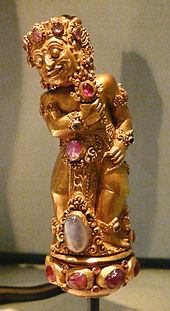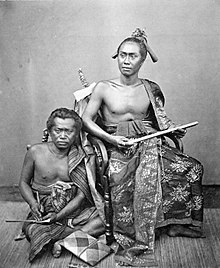Kris
Each part of the kris is considered a piece of art, often carved in meticulous detail and made from various materials: metal, precious or rare types of wood, or gold or ivory.
[13] Kris are used for display, as talismans with magical powers, weapons, a sanctified heirloom (pusaka), auxiliary equipment for court soldiers, an accessory for ceremonial dress, an indicator of social status, a symbol of heroism, etc.
[13] Legendary kris that possess supernatural power and extraordinary ability were mentioned in traditional folktales, such as those of Empu Gandring, Taming Sari, and Setan Kober.
The scene in bas relief of Sukuh Temple in Central Java, dated from 15th century Majapahit era, shows the workshop of a Javanese keris blacksmith.
[citation needed] The scene depicted Bhima as the blacksmith on the left forging the metal, Ganesha in the center, and Arjuna on the right operating the piston bellows to blow air into the furnace.
In Yingya Shenglan—a record about Zheng He's expedition (1405–1433)—Ma Huan describes that all men in Majapahit, from the king to commoners, from a boy aged three to elders, slipped pu-la-t'ou (belati or more precisely kris dagger) in their belts.
Scientists suspect that due to its special features the kris might be even older, but was decorated during Majapahit period to celebrate an important event.
Yearly cleanings, known in Javanese tradition as jamasan, is required as part of the spirituality and mythology surrounding the weapon, often left ancient blades worn and thin.
They carry them at the back, as daggers used to be in Portugal ...In many parts of Indonesia and the Malacca Sultanate, the kris used to be the choice weapon for an execution known as the hukuman salang.
The forging of edged weapons went into decline from the moment that the sultans or rajas were subjugated and their realms annexed by the British or Dutch East Indies colonial state.
[9]: 30 However its spiritual and ceremonial function still continues and is celebrated mainly in kraton and istana (courts) throughout Indonesia, Malaysia and the Muslim-inhabited parts of the southern Philippines.
In Java, the traditional art of kris-making is preserved in the Javanese culture heartland, the keraton (royal court) of Yogyakarta and Surakarta, and also the princedom of Mangkunegaran and Pakualaman.
Although active and honoured smiths who produce high quality kris in the traditional way can still be found in some places such as Madura, Surakarta, Yogyakarta, Makassar and Palembang, their number is dramatically decreasing, and it is more difficult for them to find successors to whom they may transmit their skills.
[24] Physically, the kris is a form of dagger with a blade measuring between 15 and 50 in (38 and 127 cm) long, typically not sharpened as it is meant for stabbing and tearing, broader and asymmetric shape near the hilt, made of a combination of several kinds of metals.
Different types of whetstones, acidic juice of citrus fruits and poisonous arsenic bring out the contrast between the dark black iron and the light colored silvery nickel layers which together form pamor, damascene patterns on the blade.
Traditionally the pamor material for the kris smiths connected with the courts of Yogyakarta and Surakarta originates from an iron meteorite that fell to earth at the end of 18th century in the neighborhood of the Prambanan temple complex.
The meteorite was excavated and transported to the keraton of Surakarta; from that time on the smiths of Vorstenlanden (the Royal territories) used small pieces of meteoric iron to produce pamor patterns in their kris, pikes, and other status weapons.
[9]: 19 The handle or hilt (hulu) is an object of art, often carved in meticulous details and made from various materials: precious rare types of wood to gold or ivory.
Kris are used for display, as talismans with magical powers, weapons, sanctified heirloom, auxiliary equipment for court soldiers, as an accessory for ceremonial dress, an indicator of social status, a symbol of heroism, etc.
The addition of jasmine arrangement around the kris was meant as a symbol that a man should not easily be angry, cruel, fierce, too aggressive, tyrannical and abusive.
Ken Arok used Mpu Gandring's cursed kris to assassinate Tunggul Ametung, cunningly put the blame to Kebo Ijo, and built a new kingdom of Singhasari.
The bloody feud continued on and on until the reign of Kertanegara, the last king of Singosari Empire Taming Sari ("flower shield") is one of the most well-known kris in Malay literature, said to be so skilfully crafted that anyone wielding it was unbeatable.
Tun Sri Lanang's book, the Sejarah Melayu, tells that it was made by a Javanese empu and first used by the champion of Majapahit, a pendekar named Taming Sari.
Javanese folk story tells of Arya Penangsang, the mighty viceroy (adipati) of Jipang who was killed by his own kris called Setan Kober ("devil of the grave").
Kikin's son, Penangsang of Jipang with the help of his teacher, Sunan Kudus, took revenge by sending an assassin to kill Prawoto using the Setan Kober kris.
When trying to attack his opponent, the reckless, fierce and impatient Panangsang pulled his Setan Kober off its sheath, but accidentally cut his own intestines and died.
Impressed by Penangsang's deed, later he command his male descendants to follow his step, adorned the kris with "intestine" made from the chain of jasmine, as a symbol of bravery.
As a cultural symbol, the meticulously decorated kris represent refinement, art and beauty, as the pride and prized possession for its owner;[29] however, as a weapon it is associated with violence, death and bloodshed.
In the British colonies of future Federation of Malaya, the kris has become a symbol of early Malay nationalism (see Malaya's proposed flag designs); especially of the ethno-majoritarian right-wing ketuanan Melayu strain decades on post-independence; it is incorporated into theSang Saka Bangsa, party flag of United Malays National Organisation once dominant in Malaysian politics.
[45] In the Philippines, the kalis, a larger sword variant of the kris, is a symbol of Moro and southern Filipino culture, and a resistance to Spanish rule and influence.
















